Fire Aviation USA and Canada
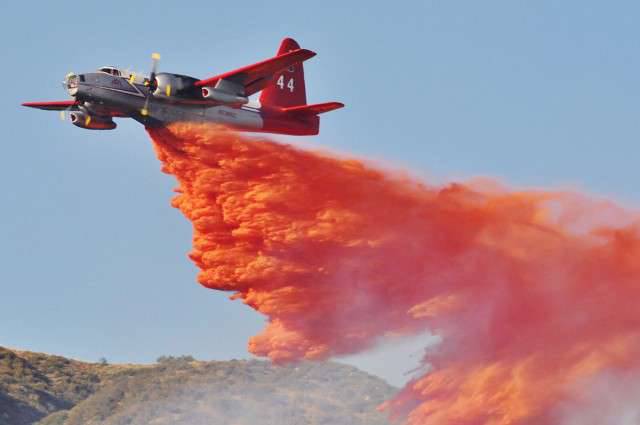
Hundreds of thousands of square kilometers of forest land burn out on our planet annually. Forest fires cause enormous damage. In addition to environmental damage, industrial wood, animals, and often people, perish in the fire. In order to timely detect fires and prevent the spread of fire to vast territories in many countries, special aviation fire service. Since forests often occupy a large area, fire aviation has been used for many decades to quickly record a fire and localize it. It has the widest range of tasks - from detecting a source of ignition and transmitting information about it to ground services to completely eliminating a forest fire.
The first attempts to combat the fire element from the air were recorded in the United States and Canada at the end of the 20 of the last century. However, due to the small carrying capacity of the fragile biplanes of those years could take on the strength of several hundred liters of water, and their effectiveness in this field was low. The idea itself was recognized as promising, but it was not yet suitable for its implementation. Then there was much more benefit from the transfer to the forest airfields of fire brigades, water pumps, fuel and equipment.
Much has changed since the end of the Second World War, when a huge excess of written-off military aircraft, still in very good condition, and demobilized qualified pilots was formed. However, it took some time for the American authorities to realize the possibility of transferring converted combat aircraft to private hands and fire services. Therefore, Stearman RT-17 training biplanes were originally used for fire-fighting purposes. In 30-40-ies, the RT-17 was the "training class" of the US Air Force pilots.
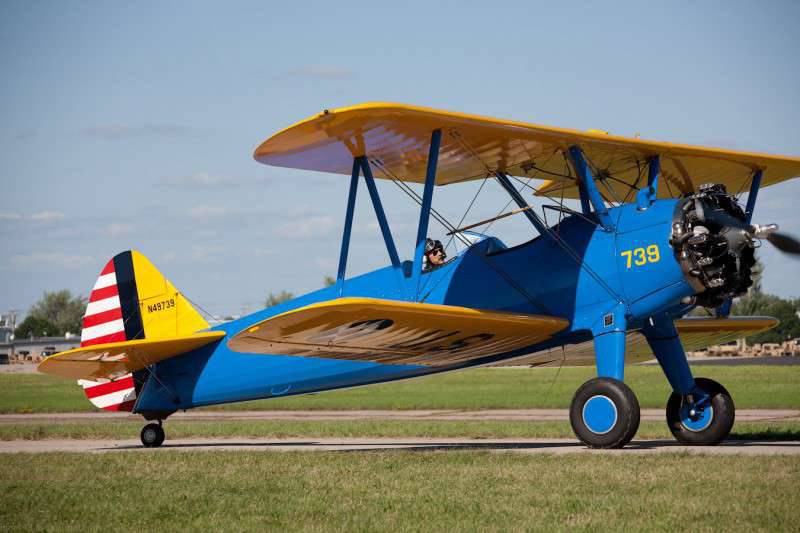
Initially transferred to civilian owners, the biplanes RT-17 were used to disperse pesticides in the fight against agricultural pests. In place of the cockpit cockpit installed capacity volume 605 liters. And although the amount of water discharged at a time was small, the experience of "combat use" showed that in combination with an advanced network of aerial reconnaissance and total radioification of firefighting aircraft, with timely detection of fire, while its center is still small, even light aircraft can be very effective.
The first in the United States to create a serious fleet of fire aviation began the state of California, which annually suffers from fires in the summer. In 1954, the first TBM Avenger deck torpedo bomber, bought at a bargain price from the Navy, was converted. Turn it into a fire truck turned out to be easy. All unnecessary military equipment and armament suspension units were dismantled from the aircraft. Water tanks or a fire extinguishing agent with a volume of about 1300 liters together with a drain system were placed in the free bomb bay. There were several tanks; this allowed minimizing the harmful effects of water swinging in flight, improving centering and ensuring alternate or volley discharge of water, depending on the nature and extent of the forest fire. The aircraft were painted in bright colors characteristic of the fire brigade.
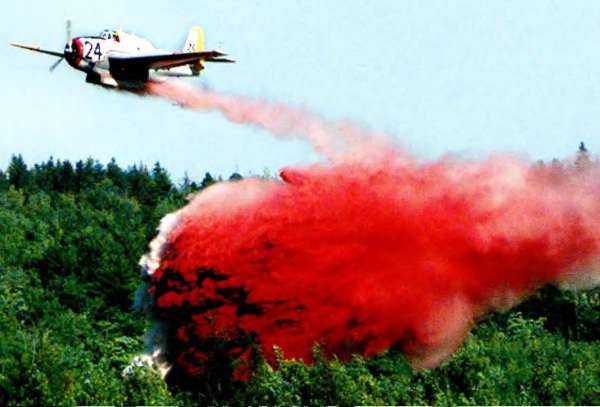
"Events" is often called "water bombers." In the 50-s in North America, an entire air army of such “water bombers” was formed, enough in number to recruit flight wings for a pair of aircraft carriers. In the fire aviation life "Avenger" was very long. The US Forest Service and a number of companies such as Cisco Aircraft, TVM Inc, Sis-Q Flying Services, and Hemet Valley Flying Services exploited dozens of former "batchers" before the start of 90's, and in Canada extinguished fires in 2000.
The successful use of the Evenger as an airfighter opened the way for other obsolete piston bombers, which in the US 50 in the United States formed a large surplus. The air force and the fleet were abandoned, the multi-ton voracious cars were not needed by private owners, and the airlines for the transportation of passengers and cargo were preferred by more economical specialized airliners. Even for nothing, in the framework of free military assistance, the queue for piston bombers did not line up. US allies preferred single-engine, more flexible and cheaper to maintain, such as the Р-51 or А-1. Under these conditions, in 50-60-s, the conversion to “flying water tankers” saved tens of North American B-25, Douglas A-26, and Consolidated B-24, Boeing B-17 bombers from cutting into metal. Compared with the "Evander", two and four motor vehicles had a greater capacity and reliability.
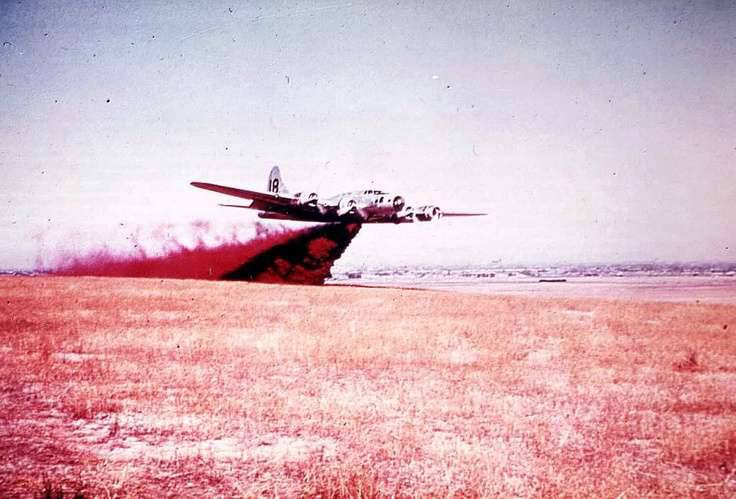
As the development of the resource of the bombers of the Second World War, the question arose of replacing them. After serving their service in the forest, many aircraft took pride of place in museum exhibitions and starred in feature films. However, some of the vintage cars continue to serve. So, until recently, a huge flying boat Martin JRM "Mars" was involved in extinguishing fires. In total, seven cars were built before 1947. Two "Mars" in October-November 2007 took part in extinguishing forest fires in California. In 2012, one car was written off, and it was announced that it would go to the National Maritime Aviation Museum.
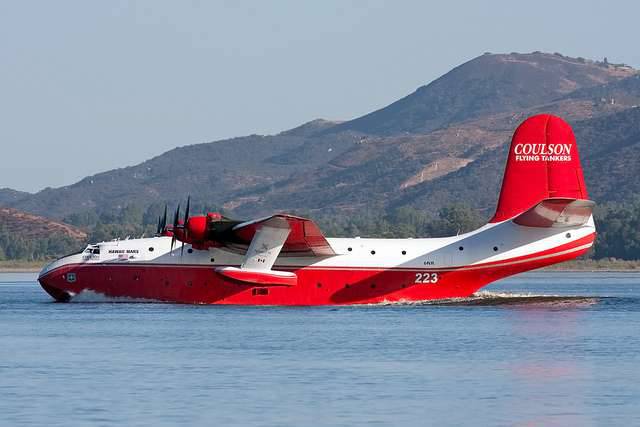
Despite their advanced age, “Marshes” proved to be very effective in extinguishing fires. Due to the large reserves of fuel, the duration of work on one refueling in the mode of intensive fire extinguishing - 6 hours, while the aircraft is able to perform 37 full cycles of intake and discharge of water.
An inexhaustible source of replenishment of the fleet of firefighters has become the storage base for the aircraft equipment Davis-Montana in Arizona. Much of the S-2 Tgaseg and P-2 Neptune antisubmarines stored here were later converted into fire engines.
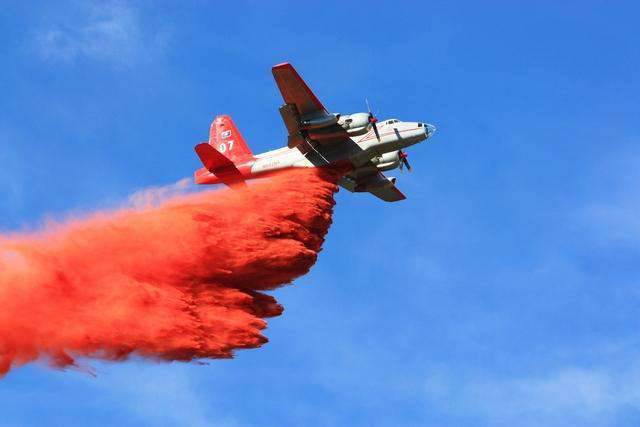
Good take-off and landing characteristics, unpretentiousness, relatively inexpensive parts and maintenance, large internal volumes - all this made them very attractive for fire services. Some S-2 and P-2 have been flying to the USA so far.
In the 70-80-years, the practice of replenishing the fire-fighting aviation fleet with obsolete Air Force and Navy planes continued. Naturally, jet bombers were no longer suitable for dumping water from low altitude. The base patrol P-3A Orion, the military transport C-54 Skymaster and C-130 Hercules of the first modifications went into action. Their ranks were also joined by civil airliners DC-4, DC-6, DC-7 and even wide-body DC-10, which, as they were replaced by modern aircraft, the airlines began to refuse. As a result, a very diverse fleet of firefighting aircraft was formed in the United States, which is explained by the bargain prices of used aircraft. For fire aviation, the criteria for high fuel efficiency and comfort are of no primary importance. It is much more important how much fire extinguishing fluid a plane can take and how reliable and easy it is to maintain.
However, recently, due to a series of catastrophes caused by the fatigue destruction of the airframe structure, there has been a tendency to replace old, initially unsuitable for extinguishing aircraft fires, whose age has exceeded 50 years, with specialized machines. In the US, fire services, in contrast to Canada, mainly use airplanes based on land aerodromes. This is explained by the fact that large forests of industrial importance are located in the western United States, where reservoirs suitable for planting seaplanes are quite rare. At the same time, as a fire extinguishing agent, instead of water, flame retardants are used - solutions and suspensions, which have greater efficiency and a slower evaporation rate than pure water. Since ordinary water is far from an ideal extinguishing agent: in hot weather, it quickly evaporates, and the combustion is restored and continues with the same force.
In the United States, the main "strike force" of the aviation fire brigade is currently heavy vehicles, built on the basis of wide-body airliners of civilian airliners and military transport aircraft. Large payloads can partly compensate for the low productivity of airfield-based vehicles compared to amphibians.
For example, Evergreens operates a Boeing 747ST Supertanker, converted from a B-747-200F truck, capable of discharging water to 90000 l in one run. BAe-146 aircraft and converted KS-10 refueling aircraft are also widely used.
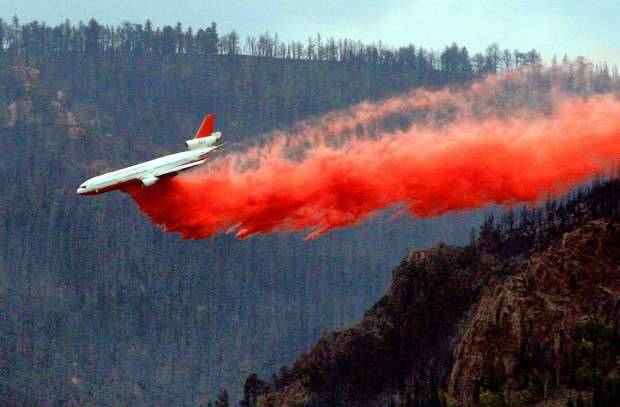
Since 60-s, they began to actively use helicopters with spillway devices on the external sling for firefighting. The advantage of helicopters, despite the high operating costs and limited carrying capacity, is the ability to fill water tanks in almost any reservoir in the hover mode, as well as greater efficiency due to increased discharge accuracy. It usually takes only a few seconds to fill the container. The first experiments in this area were carried out in 1957 year on a light Bell 47 helicopter. He delivered water in rubber bags with a capacity of 250 liters, mounted under the fuselage.
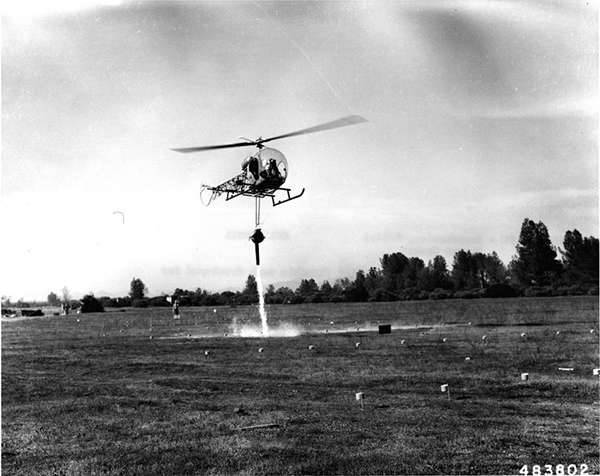
An alternative, but rather rarely used method is water intake into the internal tanks, placed inside the helicopter with the help of a pump in the hover mode. This method, for example, uses the fire-fighting version of the S-64 Skycrane helicopter.
Before 1961, helicopters were hardly used to protect forests from fires in the United States, as there were few of them in commercial airlines, and the military isolated helicopters only in critical situations, when forest fires became uncontrollable. After the “helicopter boom” began in the world at the end of 60's, and affordable and reliable models appeared on the civilian market, the use of helicopters in forest conservation became commonplace.
For air patrols and the timely detection of fires, a wide variety of light aircraft are actively used. In the US, they are called birddogs - "sniffer birds." If earlier the search for fires was carried out visually, then now the FUR infrared system, which is capable of automatically detecting an open fire and “seeing” through the smoke, both day and night, is part of the equipment of the scouts. In addition to standard communications equipment, satellite navigation systems and real-time data transmission equipment are installed on aerial reconnaissance aircraft. This allows even in flight to drop the coordinates of the fires on ground command posts and quickly begin to fight fire. Until now, light patrol airplanes are a more reliable and operational means of controlling forest fires compared with a satellite monitoring system. However, more and more often for these purposes unmanned aerial vehicles are involved.
Former anti-guerrilla OV-10 Bronco aircraft converted into patrol aircraft are deservedly very popular among firefighter pilots in the United States. During extinguishing fires, the Bronco, which has excellent maneuverability and good visibility from the cockpit, is used as air command posts, coordinating the actions of ground forces and fire fighting aircraft.
Special mention deserves the aircraft Air Tractor AT-802 Fire Boss, equipped with special floats Wipaire. On this relatively small plane there are several tanks for the fire extinguishing composition with a total volume of 3066 liters. The presence of floats and excellent take-off and landing characteristics make it possible to produce water from small bodies of water inaccessible to other, larger hydroplanes. AT-802 Fire Boss - "Lord of Fire" - due to its high reliability and efficiency at low operating costs, has become a real bestseller of Air Tractor, also known for its agricultural aircraft and light attack aircraft.
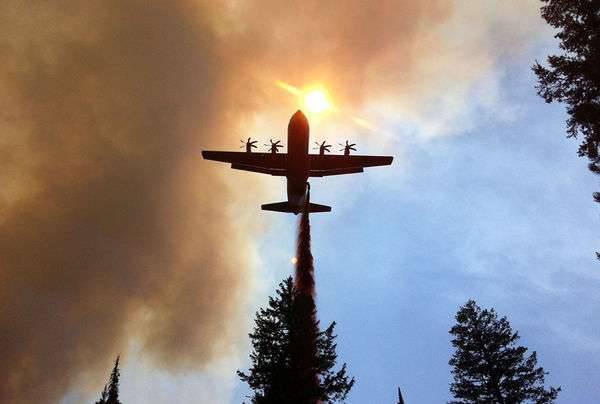
During major forest fires, when a state of emergency is introduced in individual states, as in other countries, at the request of the National Interagency Fire Center (NIFC), aircraft of the Air Force, Navy and National Guard are involved in the fight against fire. Most often, the military transport C-130 is used for water discharge. Especially for aircraft versions C-130H / J Hercules created an onboard fire extinguishing system for large ground fires MAFFS II. System modules and tanks can be installed on military transport aircraft during 4 hours.
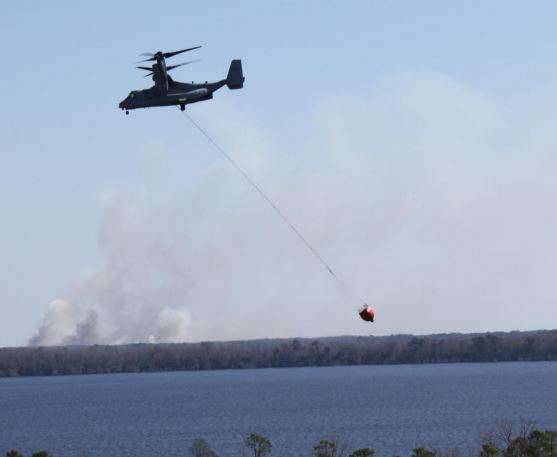
In California, especially often suffering from fires, the Bell V-22 Osprey converters from the United States International Law Commission did very well. These devices combine the individual advantages of the aircraft and the helicopter. Osprey surpasses most helicopters in terms of carrying capacity, while at the same time it is capable of carrying out water into the harness in hover mode or at low speed.
A few years ago, the US Forest Service (USFS), in its experience of using Russian firefighting aircraft during extinguishing major fires in Spain and France, expressed a desire to purchase or rent several Be-200ES. Forest Service specialists noted that the Be-200ES has a shorter approach time to the fire site, a longer range, and a better view from the pilots' workplaces compared to the Canadair CL-415 amphibian firefighter. Due to the high rigidity of the Russian fire plane is able to produce water in mountain lakes on courses that are inaccessible to other seaplanes. The maneuverability characteristics of the Be-200ČS allow it to perform tasks in high turbulence. Unfortunately, due to circumstances beyond the control of the Russian side, this promising transaction did not take place. It is obvious that politics and lobbying interests of foreign manufacturers intervened in the matter.
Unlike most of the United States, the territory of Canada abounds in numerous reservoirs. Therefore, in Canada, especially in the French-speaking provinces, in addition to land-based fire aircraft, there are many amphibians, float-operated seaplanes and flying boats. The practice of fighting forest fires has shown that a seaplane has significant advantages over airfield-based airplanes, since it can produce water on a gliding in any nearby large reservoir. This significantly reduces the time of delivery of water to the fire. Land vehicles require equipped airfields with special ground infrastructure for the delivery of water and the manufacture of fire-fighting liquids and their refueling.
In 1950, the De Havilland Beaver float began to be used in Canada, followed by the DHC Beaver and the DHC Otter - they had tanks placed inside the floats filled with water on the ground or planed on the surface of the reservoir.
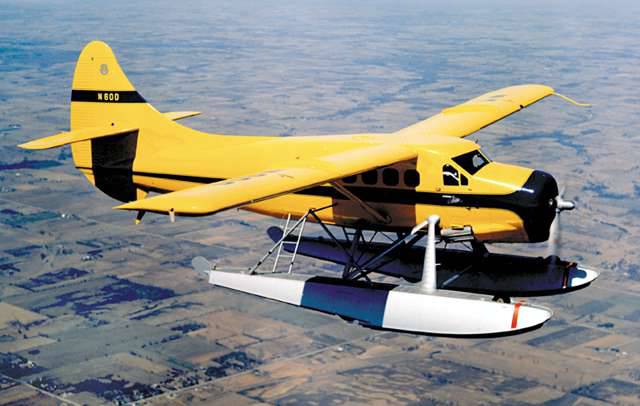
Beginning with 1958, PBY-6A Canso (Canadian version of Catalina) removed from the amphibian began to enter the Canadian fire service. On these machines, suspended tanks with a capacity of 1350 liters were placed under the wings. Later, additional tanks were installed inside the fuselage, while the water supply increased to 2500 liters. In 1971, the Canadian Catalins underwent modernization, they installed two water tanks with a total capacity of 3640 liters and a system for supplying special chemical substances to the tanks - preventing the rapid evaporation of water. This version of the amphibian was named Canso Water Bomber - “Canceau Water Bomber”.
In 1959, FIFT acquired four giant flying boats, the Martin JRM Mars, in the United States. They became the largest Canadian firefighter aircraft and were used until the beginning of the 2000's.
But the most optimal was the Canadair CL-215 amphibious aircraft. It first took off in October 1967 and was specially designed to extinguish forest fires from the air, taking into account the operating experience of previous models. The aircraft turned out to be very successful and was a success both in Canada and on the foreign market. Its serial production continued until 1990, with a total of 125 amphibious firefighters built. Gradually, the CL-215 replaced all the Catalins decommissioned after their service life was depleted. Initially, the aircraft was powered by Pratt & Whitney R-2800 piston air-cooled engines with a capacity of 2100 hp. each.
The Canadair CL-215 firefighters especially distinguished themselves in May 1972. Then, after receiving information from the patrol aircraft, the crews of several amphibians, despite the dry windy weather, managed to stop the spread of the strongest fire moving in the direction of the city of Val dOr. The railway station, tanks with liquefied combustible gas, oil storage and the city itself were located in the area of fire spread. In total, six aircraft took part in the fight against fire, and the first two amphibians arrived within 15 minutes after receiving an alarm signal. Water on gliding CL-215 was taken in a nearby lake, discharging at one minute intervals. Two hours later, the fire was stopped a few dozen meters from the railway station.
With the accumulation of operating experience, the modernization of the aircraft was ripe, and at the end of the 80s a modification of the CL-215T with turboprop engines appeared, and in 1993 the CL-415, an improved version with new avionics, tanks increased to 6130 liters, improved aerodynamics and an upgraded system plum. The aircraft is equipped with a Pratt & Whitney Canada PW123AF theater with a capacity of 2 hp. In addition to the water tanks, the aircraft has tanks for concentrated fire fighting foam and a mixing system.
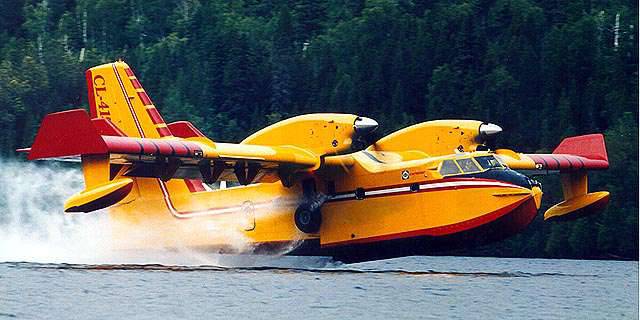
The amphibious capabilities of the CL-415 are not limited to the discharge of water, this aircraft can also be used to deliver rescue teams and special equipment and carry out search and rescue operations in disaster areas. After being converted into a passenger transport version, its passenger capacity is 30 people. To date, the Canadair CL-90 Amphibious 415 has been built.
The practice of using aircraft in the fight against forest fires has shown that they have significant advantages over ground-based means. Fire planes and helicopters can quickly reach the source of fire anywhere, including where access from the ground is simply impossible, and start extinguishing before the fire has spread to a significant area. The use of aviation requires the involvement of significantly fewer people and often costs less than the fight against fire on earth. This minimizes the risk of death and injury to personnel involved in the fight against fire elements. The trends in the development of fire aviation in the United States and Canada demonstrate that specially designed aviation equipment and equipment are becoming increasingly in demand, and outdated aircraft converted from decommissioned are gradually becoming a thing of the past.
Based on:
http://fireaviation.com
http://www.soldatru.ru/read.php?id=1239
http://tangentlink.com/papers/

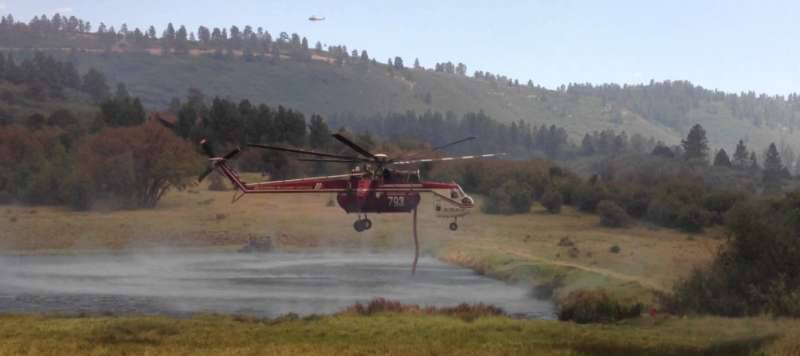
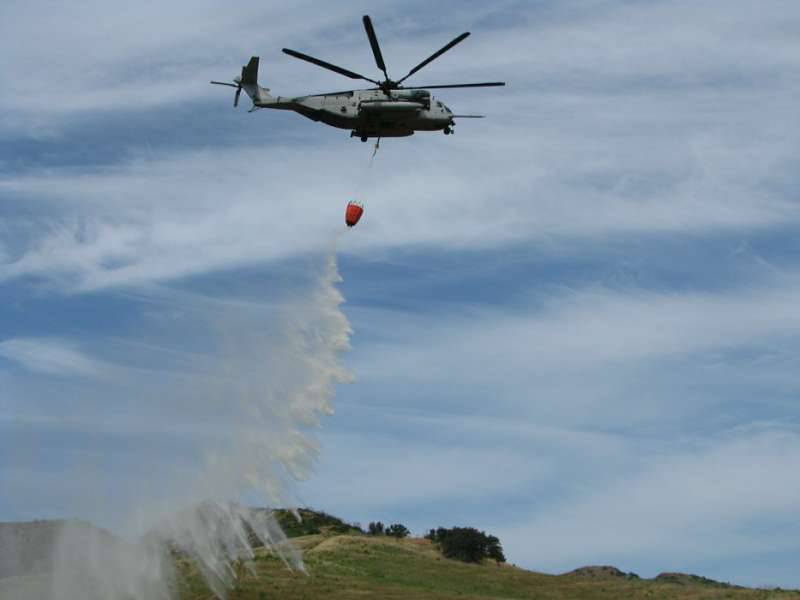
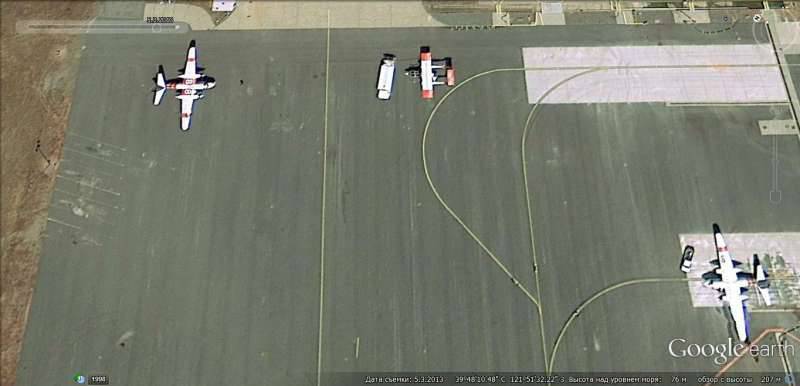
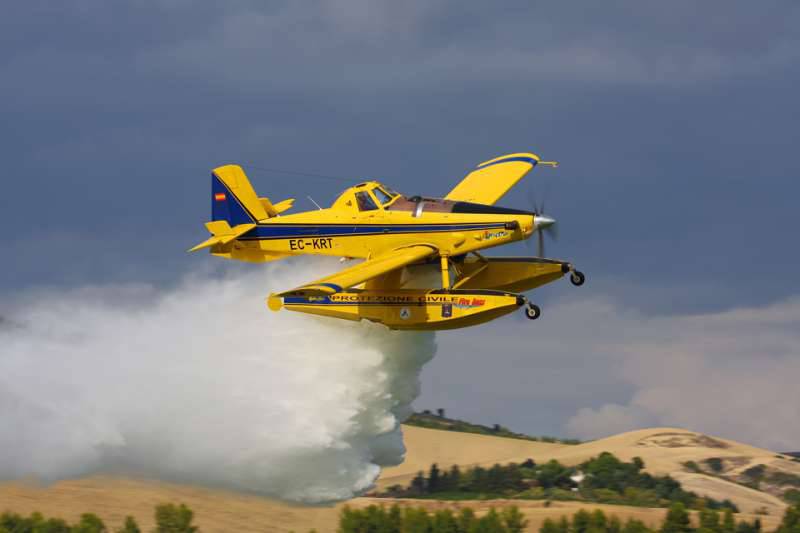
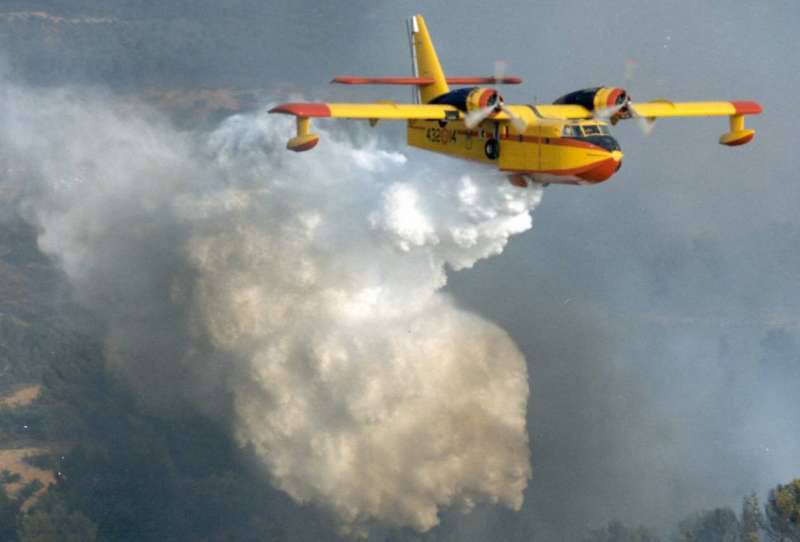
Information